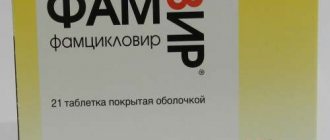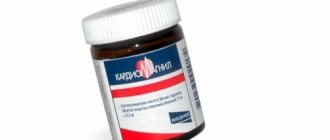Lorista N, 12.5 mg+50 mg, film-coated tablets, 60 pcs.
Losartan
Angioedema.
Patients with a history of angioedema (of the face, lips, pharynx and/or larynx) should be closely monitored.
Arterial hypotension and hypovolemia (dehydration).
In patients with hypovolemia (dehydration) and/or reduced sodium content in the blood plasma during diuretic therapy, restriction of salt intake, diarrhea or vomiting, symptomatic arterial hypotension may develop, especially after taking the first dose of Lorista® N. Before using the drug, it should be restored BCC and/or sodium content in blood plasma.
Water and electrolyte imbalances.
Fluid and electrolyte imbalances are common in patients with impaired renal function, especially in the setting of diabetes mellitus. In this regard, it is necessary to carefully monitor the potassium content in the blood plasma and creatinine clearance, especially in patients with heart failure and creatinine Cl 30-50 ml/min.
Concomitant use with potassium-sparing diuretics, potassium supplements, salt substitutes containing potassium, or other drugs that can increase the level of potassium in the blood plasma (for example, heparin) is not recommended.
Liver dysfunction.
The concentration of losartan in the blood plasma increases significantly in patients with liver cirrhosis, so Lorista® N should be used with caution in patients with mild or moderate liver dysfunction.
Renal dysfunction.
Impaired renal function, including renal failure, may occur due to inhibition of the RAAS (especially in patients whose renal function is dependent on the RAAS, such as those with severe heart failure or a history of renal dysfunction).
Renal artery stenosis.
In patients with bilateral renal artery stenosis, as well as stenosis of the artery of the only functioning kidney, drugs affecting the RAAS, incl. and ARA II, can reversibly increase the concentrations of urea and creatinine in the blood plasma.
Losartan should be used with caution in patients with bilateral renal artery stenosis or arterial stenosis of a solitary kidney.
Kidney transplantation.
There is no experience with the use of Lorista® N in patients who have recently undergone kidney transplantation.
Primary hyperaldosteronism.
Patients with primary hyperaldosteronism are resistant to antihypertensive drugs that affect the RAAS, therefore, in such patients, the use of Lorista® N is not recommended.
IHD and cerebrovascular diseases.
As with the treatment of any antihypertensive drugs, an excessive decrease in blood pressure in patients with coronary artery disease or cerebrovascular diseases can lead to the development of myocardial infarction or stroke.
Heart failure.
In patients whose renal function depends on the state of the RAAS (for example, with CHF III–IV functional class according to the NYHA classification, accompanied or not accompanied by impaired renal function), therapy with drugs affecting the RAAS may be accompanied by severe arterial hypotension, oliguria and/or progressive azotemia, and in rare cases, acute renal failure. It is impossible to exclude the development of these disorders due to suppression of RAAS activity while taking ARA II.
Stenosis of the aortic and/or mitral valve, HOCM.
Lorista® N, like other vasodilators, should be used with caution in patients with hemodynamically significant stenosis of the aortic and/or mitral valve, or HOCM.
Ethnic characteristics.
Losartan (like other drugs that affect the RAAS) has a less pronounced hypotensive effect in patients of the Black race compared to representatives of other races, possibly due to the higher incidence of hyporeninemia in these patients with arterial hypertension.
Hydrochlorothiazide
Arterial hypotension and disturbances of water and electrolyte metabolism.
It is necessary to monitor blood pressure, clinical signs of impaired water and electrolyte metabolism, incl. dehydration, hyponatremia, hypochloremic alkalosis, hypomagnesemia or hypokalemia, which may develop against the background of diarrhea or vomiting.
Serum electrolyte levels should be monitored periodically.
Metabolic and endocrine effects.
Caution is necessary in all patients receiving treatment with oral hypoglycemic agents or insulin, because hydrochlorothiazide may weaken their effect. During therapy with thiazide diuretics, latent diabetes mellitus can manifest itself.
Thiazide diuretics, including hydrochlorothiazide, can cause fluid and electrolyte imbalance (hypercalcemia, hypokalemia, hyponatremia, hypomagnesemia and hypokalemic alkalosis).
Thiazide diuretics may reduce renal excretion of calcium and cause a temporary and slight increase in plasma calcium.
Severe hypercalcemia may be a sign of hidden hyperparathyroidism. Before testing the function of the parathyroid glands, thiazide diuretics must be discontinued.
During treatment with thiazide diuretics, it is possible to increase the concentration of cholesterol and triglycerides in the blood serum.
Therapy with thiazide diuretics may worsen hyperuricemia and/or aggravate gout in some patients.
Losartan reduces the concentration of uric acid in the blood plasma, so its use in combination with hydrochlorothiazide neutralizes the hyperuricemia caused by the thiazide diuretic.
Liver dysfunction.
Thiazide diuretics should be used with caution in patients with impaired liver function or progressive liver disease, as they can cause intrahepatic cholestasis, and even minimal disturbances in water and electrolyte balance can contribute to the development of hepatic coma.
The drug Lorista® N is contraindicated in patients with severe liver dysfunction, because there is no experience in using the drug in this category of patients.
Acute myopia and secondary acute angle-closure glaucoma.
Hydrochlorothiazide is a sulfonamide that can cause an idiosyncratic reaction leading to transient acute myopia and acute angle-closure glaucoma. Symptoms include: sudden decrease in visual acuity or eye pain, usually occurring within hours to weeks of starting hydrochlorothiazide therapy. If left untreated, acute angle-closure glaucoma can lead to permanent vision loss.
Treatment:
Stop taking hydrochlorothiazide as soon as possible. If IOP remains uncontrolled, emergency medical treatment or surgery may be required. Risk factors for the development of acute angle-closure glaucoma are: a history of an allergic reaction to sulfonamide or benzylpenicillin.
Are common
In patients taking thiazide diuretics, hypersensitivity reactions may develop with or without a history of an allergic reaction or bronchial asthma, but are more likely if there is a history of such.
There are reports of exacerbation of systemic lupus erythematosus with the use of thiazide diuretics.
Special information on excipients
The drug Lorista® N contains lactose, therefore the drug is contraindicated in patients with lactase deficiency, lactose intolerance, and glucose-galactose malabsorption syndrome.
Impact on the ability to perform potentially hazardous activities that require special attention and quick reactions (for example, driving vehicles, working with moving mechanisms).
At the beginning of therapy, Lorista® N may cause a decrease in blood pressure, dizziness or drowsiness, thus indirectly affecting the psycho-emotional state. For safety reasons, patients should first assess their response to treatment before engaging in activities requiring increased alertness.
Compound
One tablet of Lorista N contains:
- 50 mg losartan potassium ;
- 12.5 mg hydrochlorothiazide ;
- magnesium stearate, MCC, lactose monohydrate, pregelatinized starch.
Lorista ND tablets contain:
- 100 mg losartan potassium ;
- 25 mg nidrochlorothisiad ;
- magnesium stearate, MCC, lactose monohydrate, pregelatinized starch.
The shell consists of hypromellose , quinoline dye (yellow), talc, macrogol 4000 and titanium dioxide (E171).
Overdose
An overdose of losartan has the following symptoms: significant decrease in blood pressure, bradycardia , tachycardia . If symptoms of overdose are detected, treatment is recommended: symptomatic treatment, forced diuresis. Hemodialysis is ineffective in this case.
An overdose of hydrocholorothiazide may cause the following symptoms: hypochloremia , hypokalemia , hyponatremia . In this case, symptomatic treatment is prescribed.
Price, where to buy
The price of Lorista ND in Russia averages 350 rubles, in Ukraine – 112 UAH.
The average price for Lorista N in Russia is 214 rubles, in Ukraine – 114 UAH.
- Online pharmacies in RussiaRussia
- Online pharmacies in UkraineUkraine
- Online pharmacies in KazakhstanKazakhstan
ZdravCity
- Lorista ND tablets p.p.o.
100mg+25mg 60 pcs. Krka-Rus LLC 809 rub. order - Lorista tablets p.p.o. 50 mg 60 pcs. Krka-Rus LLC
RUR 387 order
- Lorista N tablets p.p.o. 50mg+12.5mg 30 pcs. Krka-Rus LLC
RUB 298 order
- Lorista N tablets p.p.o. 50mg+12.5mg 60 pcs. Krka-Rus LLC
RUR 542 order
- Lorista N tablets p.p.o. 50mg+12.5mg 90 pcs.KRKA/Krka-Rus LLC
RUR 648 order
Pharmacy Dialogue
- Lorista N (tab.p.pl/vol. 100 mg + 12.5 mg No. 30) KPKA
416 RUR order
- Lorista ND (tab.p.pl/vol. 25mg+100mg No. 90)KPKA
1026 rub. order
- Lorista ND (tab.p.pl/vol. 25mg+100mg No. 60)KPKA
RUB 894 order
- Lorista (tab.p.pl/vol. 100 mg No. 30)KPKA-RUS
RUB 273 order
- Lorista ND (tab.p.pl/vol.25mg+100mg No. 30)KPKA
RUR 524 order
show more
Pharmacy24
- Lorista H 100 mg/12.5 mg No. 30 tablets KPKA, d.d., Novo mesto, Slovenia
76 UAH. order - Lorista HD 100mg/25mg No. 30 tablets KPKA, d.d., Novo Mesto, Slovenia
199 UAH order
- Lorista 50 mg No. 30 tablets KRKA, d.d., Novo Mesto, Slovenia/TAD Pharma GmbH, Nimeččina
162 UAH order
- Lorista 50 mg N90 tablets KRKA, d.d., Novo Mesto, Slovenia/TAD Pharma GmbH, Nimeččina
335 UAH. order
- Lorista H 50 mg/12.5 mg No. 30 tablets KPKA, d.d., Novo mesto, Slovenia
183 UAH order
PaniPharmacy
- Lorista tablets Lorista tablets. 50 mg No. 90 Slovenia, KRKA dd Novo Mesto
353 UAH. order
- Lorista tablets Lorista tablets. 100 mg No. 30 Slovenia, KRKA dd Novo Mesto
179 UAH. order
- Lorista N tablets Lorista N tablets. 50mg/12.5mg No. 90 Slovenia, KRKA dd Novo Mesto
419 UAH order
- Lorista HD tablets Lorista HD tablets. 100mg/25mg No. 30 Slovenia, KRKA dd Novo Mesto
220 UAH order
- Lorista tablets Lorista tablets. 50 mg No. 30 Slovenia, KRKA dd Novo Mesto
173 UAH order
show more
Analogs
Level 4 ATC code matches:
Telmisartan
Irbesartan
Presartan
Nortivan
Candesartan
Kozaar
Aprovel
Teveten
Blocktran
Cardosal
Valsartan
Losartan
Atakand
Diovan
Valsacor
Mikardis
Vazar
Valz
Lorista
Lozap
Analogues of Lorista N include: angizar plus , gizaar forte , co-sentor , lozap plus , locard , nostasartan n , tozaar-g .
All of the above analogues also apply to Lorista ND.
Side effects
The following side effects may result from taking this medicine:
- dizziness (non-systemic and systemic), insomnia , migraine , headache, fatigue;
- palpitations, dose-dependent orthostatic hypotension, tachycardia , in severe cases - vasculitis ;
- cough, swelling of the nasal mucosa, pharyngitis , respiratory tract infections (upper sections);
- nausea, abdominal pain, diarrhea , vomiting, dyspepsia ; in rare cases - hepatitis, increased activity of liver enzymes, bilirubin, impaired liver function;
- back pain, arthralgia, myalgia ;
- Henoch-Schönlein purpura , anemia ;
- weakness, chest pain, asthenia , peripheral edema;
- itching, anaphylactic reactions, urticaria , angioedema.
Taking this drug can also affect laboratory parameters : hyperkalemia, increased levels of creatinine, urea, increased concentrations of hematocrit and hemoglobin.
Pharmacodynamics and pharmacokinetics
Both drugs (Lorista N and Lorista ND) are a combination drug that has an antihypertensive effect.
Losartan leads to an increase in renin activity and also reduces the plasma concentration of aldosterone. Reduces peripheral vascular resistance, the level of pressure in the pulmonary circulation, has a diuretic effect, and reduces afterload.
Losartan prevents the occurrence of myocardial hypertrophy and increases exercise tolerance in those patients who suffer from heart failure. Taking losartan helps lower blood pressure. Does not cause withdrawal syndrome , does not affect heart rate.
Effective in people of any gender, as well as in older people (over 65 years old).
Hydrochlorothiazide has an antihypertensive effect due to the dilation of arterioles. The effect after administration is achieved after 1-2 hours, the maximum is observed after 4 hours, lasts up to 12 hours. The hypotensive effect is achieved after administration after 3-4 days, but to achieve the optimal effect it takes up to 4 weeks.
When used separately, the pharmacokinetics of hydrochlorothiazide and losartan differ from those when used simultaneously.
Losartan is absorbed from the gastrointestinal tract. Serum concentration does not depend on the drug taken simultaneously with food. Bioavailability is at 33%. The maximum concentration is observed after 60 minutes. About 35% of the drug is excreted through the kidneys, 58% with bile.
The absorption of hydrochlorothiade after oral administration is about 60-80%. The maximum concentration is achieved from 1 hour to 5 hours. It is quickly eliminated through the kidneys as it is not metabolized.





